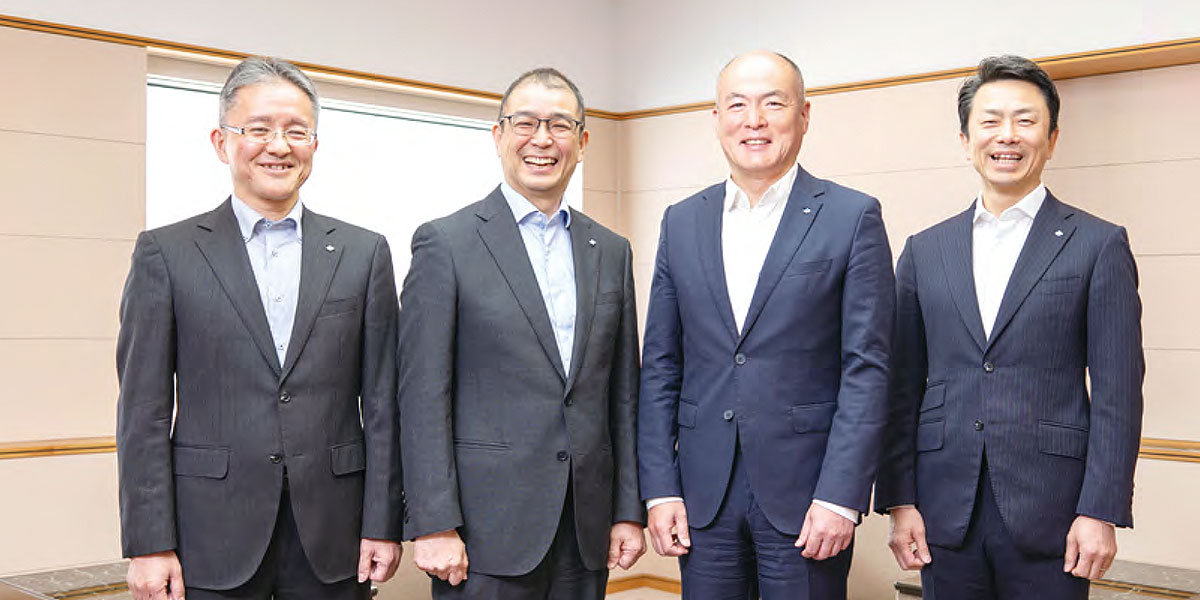
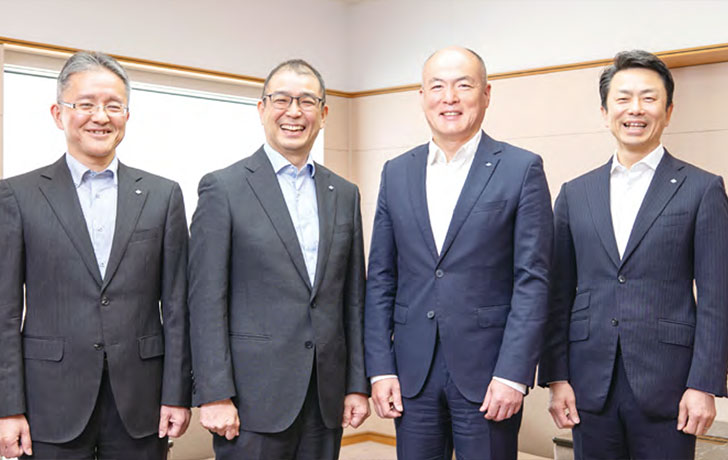
Placing Sustainability at the Foundation of Our Long-
Term Corporate Strategy to Drive Our Future
The Sumitomo Rubber Group is working to strengthen its sustainability management framework as part of its efforts to realize its long-term corporate strategy toward 2035. Four key executives responsible for leading sustainability management came together to discuss the Group’s sustainability initiatives from the perspectives of strategy, human resources, and finance.
Kuniyasu
The Group has achieved results through structural reforms and is now making a major shift toward aggressive management starting in fiscal 2025. The entire management team recognizes that a full-scale commitment to sustainability is essential for realizing sustainable growth.
For example, approximately 70% of our sales come from overseas markets, and a significant portion of our production also takes place overseas. It is therefore crucial to both empower our diverse workforce and strengthen governance at our overseas bases. Moreover, since we utilize natural rubber—a resource derived from nature—sustainable procurement and consideration for the environment and human rights are indispensable. I believe that the promotion of sustainability management will be a key factor in shaping the future of the Company.
Hino
From that perspective, we are accelerating the full-scale implementation of sustainability management. In our long-term corporate strategy announced in March 2025, we integrated sustainability to build a resilient management foundation that can withstand change.
Araki
In the long-term corporate strategy, we place strong emphasis on building a resilient management foundation that can withstand change and have incorporated investments to advance sustainability management. Given that the external environment is constantly changing, we will assess financial soundness at each stage of budgeting and mid-term planning to determine whether investments can be executed as planned. At the core of our long-term strategy is the creation of both customer value and social value through this approach.
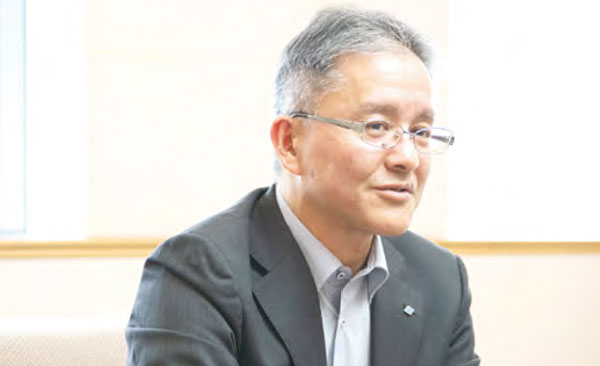
Kuniyasu
The outcome of our bold challenge to create both customer value and social value is our new product, SYNCHRO WEATHER. By enhancing tire performance, we deliver new value to customers, while also contributing to the resolution of social issues through reduced environmental impact. In this sense, the product embodies the ideal of sustainability management. Incorporating perspectives that address environmental and social challenges into our growth and product strategies is essential, and this commitment is also reflected in our long-term corporate strategy.
Tokumo
To ensure the success of our growth strategy, continuous investment in human capital is essential. Human capital management serves as the foundation for executing our long-term corporate strategy. We are committed to initiatives that enhance each individual’s performance, skills, and motivation, aiming to build a workforce and organization empowered to take on bold challenges with a strong sense of purpose.
Kuniyasu
This year marks the fifth year since we established the department dedicated to promoting sustainability in 2021. Over this period, we have reviewed our sustainability management framework by establishing the Sustainability Promotion Committee, where the management team reviews each initiative, as well as cross-functional subcommittees within the Company.
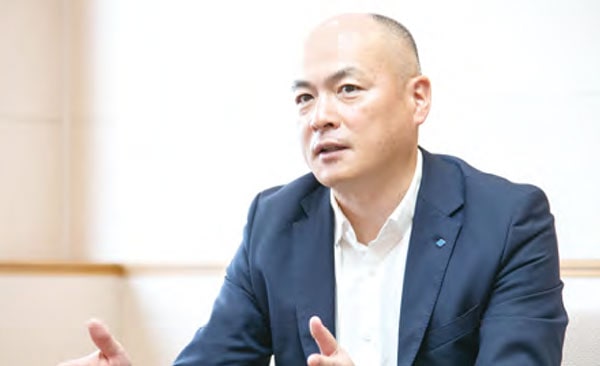
Hino
Under this framework, we revised our material issues in October 2024 with an eye toward formulating our long-term corporate strategy. We reanalyzed risks and opportunities across the entire value chain and redefined our material issues using a double materiality approach. Furthermore, we are establishing a framework that connects material issues to concrete actions. The launch of the Sustainability Advisory Board* is one such initiative.
* In January 2025, we established the Sustainability Advisory Board to facilitate dialogue between external stakeholders and management, aiming to integrate business and sustainability. To continue growing as a company in an increasingly uncertain external environment, we invited external experts to provide advice on our business’s sustainability strategies. Executive officers from each business division participated on behalf of the Company, engaging in dialogue on how to effectively integrate sustainability into their respective business operations.
Kuniyasu
The Sustainability Advisory Board serves as a forum for dialogue between external stakeholders and our business executives. To put “Our Philosophy” into practice through our business activities, we engage in discussions on which of the Group’s capitals we should leverage as strengths, and what kind of social value we aim to deliver over the long term. Through this dialogue, we are exploring and discussing the role the Company should play in building a better society.
Araki
From a financial perspective, starting in fiscal 2024, the Accounting & Finance Headquarters has been working in collaboration with the Sustainability Management Promotion Headquarters to establish a dedicated investment framework for sustainability-related initiatives. The Sustainability Management Promotion Headquarters determines the priorities within this framework, and my role is to closely monitor and ensure that our financial soundness is maintained as we move forward.
Tokumo
It is precisely because we have financial backing that we are able to take bold steps in human capital management as well.
From my position in charge of human resources, I feel a strong sense of urgency regarding the labor shortage at our domestic plants. I have recently returned to work in the field of human resources for the first time in 10 years. In recent years, I was also stationed in China, but securing talent at our domestic plants is now an even more pressing issue than overseas. A cross-functional project has already been launched to address this challenge at our domestic plants, but we must further strengthen our efforts under our long-term corporate strategy.
As a first step, starting in fiscal 2025, we have revised our engagement survey to a format that allows for comparison with other companies, establishing a framework to objectively assess our current situation. Over the next three years, we also plan to expand the survey globally.
Kuniyasu
In 2025, we established the D&I Subcommittee to deepen discussions on diversity and inclusion in our workforce.
Tokumo
Until now, the promotion of D&I has often been discussed in the context of supporting work-life balance. However, what we aim to achieve is an organization where diverse individuals can fully demonstrate their abilities, regardless of gender or attribute. We are incorporating this perspective into our initiatives at domestic plants as well. Addressing the opportunity gap between men and women caused by societal structures is also a key issue. We firmly believe that creating an environment where diverse talent can thrive will lead to the sustainable growth of our organization and contribute to the realization of our long-term corporate strategy.
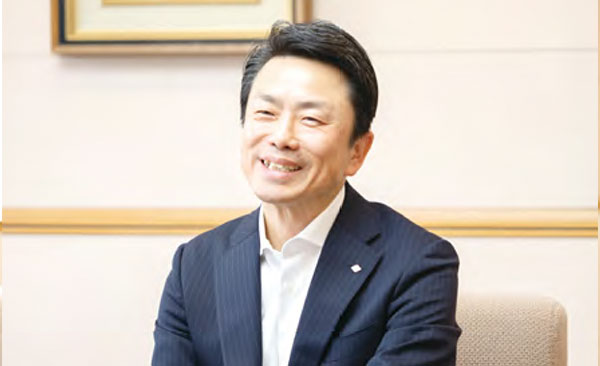
Hino
Going forward, we will enhance the effectiveness of our sustainability initiatives through both cross-functional collaboration across the subcommittees under the Sustainability Promotion Committee and vertical alignment within each business division. We are currently reviewing our Long-Term Sustainability Targets “Driving Our Future Initiatives 2050,” and will disclose these initiatives in a timely and appropriate manner.
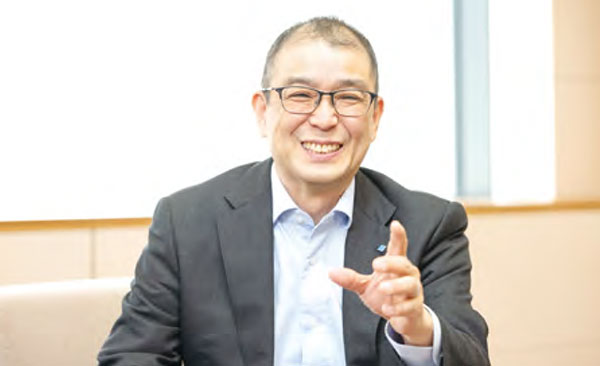
Kuniyasu
One of the key initiatives we must address is climate change. To achieve carbon neutrality in the production phase, our Shirakawa Factory is taking on the challenge of tire manufacturing using hydrogen energy and solar power. Furthermore, by accelerating product innovation, we aim to reduce carbon emissions during the usage phase of our products—for example, by contributing to improved fuel efficiency in automobiles.
Araki
We are supporting climate change initiatives also from a financial perspective. With regard to carbon neutrality, we introduced Internal Carbon Pricing (ICP) in 2023 and have since been building a system that translates CO₂ reduction effects into monetary values to inform our investment decisions.
Kuniyasu
Climate change also has a significant impact on natural rubber, one of the most important raw materials for our business. In addition to supporting existing rubber plantations—particularly smallholder farmers who are more vulnerable to climate impacts—we must also explore new sourcing methods and the development of alternative materials in parallel.
Tokumo
The procurement of natural rubber, especially at its production stage, is internationally recognized as a sector with high human rights risks, including child labor and forced labor. The Group has a responsibility to respect the human rights of all individuals involved across the supply chain, including workers on rubber plantations, employees, and business partners. In 2024, we established a cross-functional subcommittee to address human rights issues across the Group, and we are promoting initiatives through collaboration among departments. We will continue to strengthen practical, on-the-ground efforts to respect human rights.
Kuniyasu
Amid an increasingly complex business environment, governance is essential to supporting a resilient management foundation.
Tokumo
From a governance perspective, enhancing the effectiveness of the Board of Directors and strengthening the risk management framework are key priorities. Continuing from 2024, the Chair of the Board remains an Outside Director, and starting in 2025, for the first time, the Board is composed of five internal and five Outside Directors—making half of the Board independent. By increasing the Board’s independence, we aim to further ensure the proper separation between supervision and execution functions.
Hino
From an execution standpoint, we are strengthening our company-wide risk management framework to respond effectively to an era of rapid change.
Tokumo
I recognize the importance of enhancing collaboration among the Risk Management Committee, the Corporate Ethics Committee, and the Sustainability Promotion Committee, which are currently in operation. In fiscal 2024, we reviewed our key risks based on material issues and clearly identified risks related to human rights and sustainability. Going forward, we will promote more effective risk management through organizational coordination and KPI-based tracking.
Kuniyasu
Discussions are also intensifying on how to leverage technologies across business divisions. For example, we are exploring the potential to apply the ACTIVE TREAD technology developed in our tire business to other areas such as golf equipment and industrial materials. We are reviewing our traditionally siloed R&D structure with the aim of creating new value through collaboration both within and outside the Company. Furthermore, promoting sustainability management is a critical initiative that directly contributes to new revenue streams. We hope to extend these efforts beyond the tire business and into the development of new business domains.
Tokumo
Going forward, we will place greater emphasis on internal and external collaboration to drive innovation and create new value, while also developing systems that recognize and reward employee cooperation.
Kuniyasu
The Sumitomo Business Spirit, which has been passed down throughout the Sumitomo Group, includes the phrase: “placing prime importance on integrity and sound management.” The term “sound management” refers to grounded, reliable management, and achieving this requires balancing both customer value and social value. To meet the expectations of our stakeholders, including investors, we will continue to disclose our initiatives and their outcomes in a timely manner, while further strengthening our efforts to address social issues through our business activities.